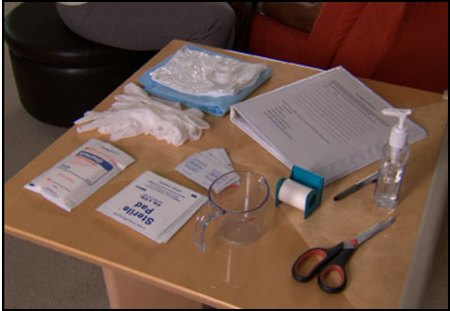Look at the Wound and Drain Site
When you manage a wound drainage system you need to learn to look at the surgical wound and the drain closely. It is important for you to recognize a wound infection or other complications early.
Call the doctor and seek immediate help when:
- There is drainage or a foul odor at the wound
- Stitches are missing or falling out
- The drain has accidentally been pulled on and is now partially or completely out. (If partially out, NEVER TRY TO REINSERT)
- The wound edges are separating
- There is increased redness, swelling, or tenderness in the skin next to the stitches or incision
- The person has a fever, with their oral temperature 100.5° Fahrenheit (38.0° Centigrade) or higher
- Wound bandages are soaked with blood
- The wound vacuum does not work
Call the doctor and seek immediate help when:
- The skin at the drain site is excessively red, swollen, tender or has drainage from the skin around the tube site
Managing the Drainage Device
- Follow the doctor’s directions for the frequency to empty a drainage device and for changing any wound dressing. See our lesson on Changing a Gauze Dressing.
- Keep the drainage device connected to the person’s clothing with a safety pin or clip so that the drain does not pull out. (Always remind the person that the device is clipped to his or her clothing to avoid accidental dislodgement).
- Wash your hands for 15 seconds before and after you provide care for a drain. See our lesson on Infection Control.
- Apply a pair of clean gloves before touching the drainage device. This protects you from transferring any germs to yourself or others.
- If there is a small dressing around the site where the drain enters the skin, remove it carefully so you do not pull the drain out.
- Make sure the drain tubing is not kinked and drainage flows freely. Check for leaks in the system.
- If you notice holes or cracks in the tubing, or in the bulb or collection container, call your home health nurse or doctor’s office immediately.
- Always keep the drainage container lower than the wound. This prevents drainage from flowing back and bathing the wound with bacteria from the collection container.
- Touch only the drainage system, if you need to provide other care remove gloves and wash your hands.
- Always wipe off the spout of the drainage device with an alcohol swab just before you close it.
- Never allow the drainage tubing to be pulled on, as this can loosen the sutures and cause the tube to come out.
- The doctor may have you measure the amount of drainage each time you empty the drain. Keep a record of the amount of drainage in your care diary.
- Empty the drain into a measuring cup or pitcher, and then empty the contents into the toilet. Mark the outside of the measuring cup “For Wound Care Only” so that you and anyone else in the home does not use the cup for other purposes.
Disposal of Medical Waste
Wound drainage is a type of medical waste. Correct disposal of medical wastes protects the family, community, and the safety of sanitation workers.
See our lesson on Disposal of Medical Waste.
- Throw away soiled or bloody gauze dressings and gloves into a plastic or leak proof bag. If the dressings are highly soiled or bloody then place this first bag into a second bag, called “double bagging”. This bag can then be thrown into your regular trash.
- Be sure to use a tightly lidded trash container so that animals are not attracted to the bloody or soiled items. Some communities request that you notify your trash hauling company and just let them know that there is medical waste at your residence.
- Dispose of bile or wound drainage into the toilet and flush twice. Avoid splashing.
- Up to date information regarding medical waste disposal is located on the Environmental Protection Agency website found in the Resources section of this lesson.
- Never place a medical waste container in a recycling bin.
